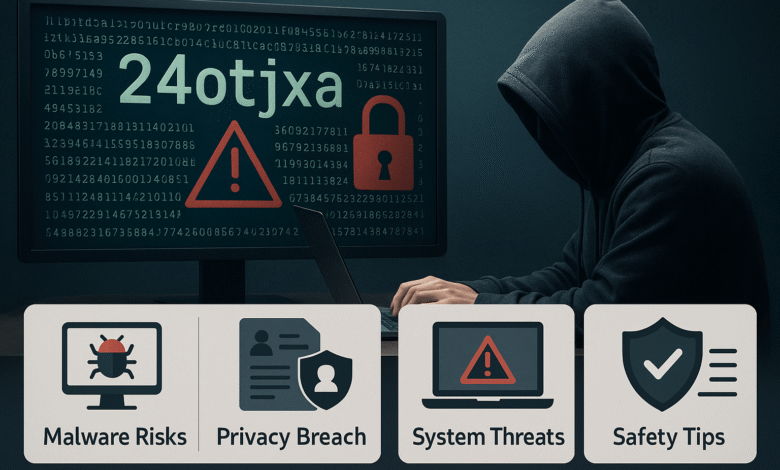Why 24ot1jxa Harmful: All You Need to Know to Stay Protected

Introduction
With the internet playing a major role in our everyday lives, digital threats have become more advanced and harder to detect. One such recent concern is tied to a mysterious term gaining attention online—24ot1jxa. While it may appear as a random alphanumeric string, many cybersecurity experts are now raising red flags about its potential dangers. So, the big question is: Why 24ot1jxa Harmful, and what can you do to shield yourself?
This article provides a complete breakdown of 24ot1jxa, detailing why it’s harmful, how it spreads, and the steps you can take to protect your devices and data.
What Is 24ot1jxa?
At first glance, 24ot1jxa seems meaningless. However, digital analysts suggest that this code may be tied to stealth malware, spyware, or bots that exploit system vulnerabilities. These programs are usually designed to steal data, hijack device operations, or spread infections across networks.
Because of its secretive behavior, 24ot1jxa often flies under the radar of traditional antivirus tools, making it particularly threatening.
Why 24ot1jxa Harmful?
Understanding why 24ot1jxa harmful is essential for your digital safety. Below are the primary dangers associated with it:
1. Data Theft and Privacy Risks
One of the most alarming risks linked to 24ot1jxa is unauthorized data access. Once embedded in your system, it can extract login details, personal files, banking credentials, and sensitive communication. This can lead to identity theft, financial fraud, or even blackmail.
2. System Disruption
Malware such as 24ot1jxa often consumes system resources, resulting in slow device performance, frequent pop-ups, or unexpected crashes. In worst-case scenarios, it can grant remote access to hackers who can control your device without your knowledge.
3. Financial Exploitation
Why 24ot1jxa harmful also ties into how cybercriminals use infected devices to generate income. This includes crypto mining, redirecting traffic for click fraud, or selling stolen data on illegal forums.
4. Network Contamination
In shared environments like offices or homes with multiple devices, one infected system can cause a domino effect, spreading the malware across the entire network. This not only compromises your security but also risks organizational integrity.
How Does 24ot1jxa Spread?
Knowing why 24ot1jxa harmful isn’t enough—it’s crucial to understand how it infiltrates systems:
-
Phishing Emails: Attackers send emails that appear legitimate, tricking users into clicking malicious links or downloading infected files.
-
Cracked or Fake Software: Many people unknowingly install 24ot1jxa bundled with pirated applications or software from shady websites.
-
Unsafe Websites: Visiting non-secure or poorly maintained websites can initiate background downloads that infect your device.
-
USB Drives and Storage Devices: Malware like 24ot1jxa can spread through infected flash drives or external storage devices.
How to Stay Safe from 24ot1jxa
Protection starts with awareness and action. Below are key strategies to safeguard against this threat:
1. Use Reliable Antivirus Software
Install and regularly update trusted antivirus tools. These can detect hidden threats like 24ot1jxa and prevent them from executing commands that might damage your system.
2. Avoid Unverified Downloads
Never download software from unknown sources. Stick to verified websites and always check digital signatures when possible.
3. Be Cautious with Emails
Always double-check the source of an email before clicking on any link or opening attachments. Phishing scams are the top method for spreading 24ot1jxa.
4. Enable Firewalls
Firewalls monitor incoming and outgoing network traffic and can block unauthorized access attempts, providing a strong line of defense against malware.
5. Update Software Regularly
Outdated operating systems and applications can have vulnerabilities that malware exploits. Always keep your system updated with the latest patches.
6. Backup Your Data
Frequent backups are essential. Use cloud services or external drives to store important data so that, if infected, you can recover without losing vital information.
7. Avoid Public Wi-Fi
Public networks are breeding grounds for cyber threats. If you must use them, consider connecting through a VPN to add an extra layer of encryption and safety.
What to Do If You Suspect a 24ot1jxa Infection
Even with precautions, infections can happen. Here’s what you should do if you suspect your system is compromised:
-
Run a Full System Scan: Use updated antivirus or anti-malware software to scan and remove threats.
-
Disconnect from the Internet: This helps prevent the malware from communicating with command centers or spreading further.
-
Inform Your IT Department: If you’re using a work device, alert your IT team immediately.
-
Restore from Backup: If removal fails, perform a full system restore using a clean backup or reset your device to factory settings.
FAQs
Q1: Is 24ot1jxa a confirmed virus?
A: While not officially listed in traditional virus databases, its behavior resembles malware and spyware, making it a serious threat.
Q2: Can antivirus programs detect 24ot1jxa?
A: Yes, but only if the software is updated and advanced enough to detect hidden or newly-emerging threats.
Q3: Why is 24ot1jxa harmful to networks?
A: Once inside a single system, it can easily spread to connected devices, especially over shared Wi-Fi or LAN environments.
Q4: What are signs of infection?
A: Slow system performance, strange pop-ups, unauthorized changes in settings, and new unknown applications.
Q5: How can I remove it completely?
A: Run malware removal tools, disconnect from networks, and if needed, reset your system or restore from a secure backup.
Final Thoughts
Now that you understand why 24ot1jxa harmful, it’s clear that digital security should never be taken lightly. The key lies in prevention: staying informed, using strong software defenses, and practicing smart online habits. If you act fast and apply safety measures diligently, you can greatly reduce the risk of falling victim to this or similar cyber threats.
Read also:Discovering zerodevice.net: A Detailed Insight into the Digital Innovation Hub



